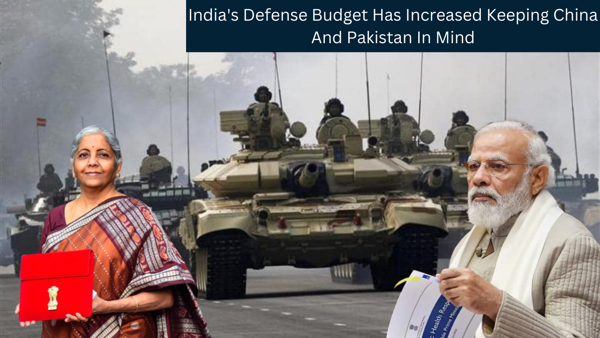
Geopolitics & World-affairs
India Has Increased Its Defence Budget: Following The Chinese Aggression And Clandestine Pakistan's Nuclear Policy On Mind
Today, India's Finance Minister, Nirmala Sitaraman, presented the budget for 2023.
She increased India's defense spending in that budget, keeping in mind India's tension with China, as well as Pakistan's clandestine approach to its economy and opaque nuclear policy.
India's defense budget increased from Rs. 5.25 lakh crores last year to Rs. 5.93 lakh crores this year.
The capital outlay of the defense budget has increased by Rs.10,000 crore, which is equivalent to a 12.5% increase in comparison to last year's.
Out of the total budget of Rs. 5.93 lakh crores government has decided to spend Rs. 1.62 lakh crores for purchasing military equipment such as submarines, fighter jets for the Indian airforce and navy, warships, missiles, and other important equipment to make Indian military formidable against the possibility of a two-front war against the Chinese and Pakistanis.
Last year, the government allocated Rs. 1.52 lakh crores for the purchase of military equipment; this year, it has increased by 6.7% and reached Rs. 1.62 lakh crores.
The main source of concern for the Indian government is the pension for retired soldiers, which is increasing year after year.
The budget allocation was Rs. 1.19 lakh crores last year; this year, it increased by 15% to Rs. 1.38 lakh crores.
India's Journey to make itself the net exporter in the defense sector:
Indian government formulated this year's budget by strengthening the foundation of development and a slew of foreign direct investment-related measures to draw foreign organizations into the country, especially the defense industry.
Indian defense industry needs investment from everywhere because India used to be the second largest importer of defense goods from other countries, now, India is reducing its dependence on imported defense goods by making its own needs using its indigenously developed defense industry.
India has set a target of $25 billion in defense equipment exports to other countries, establishing itself as a major world power in defense goods manufacturing.
This year's budget will also strongly encourage entrepreneurs to enter the defense manufacturing industry along with foreign investment firms.
While the Indian government encourages others to enter the sector, it also needs to control China's aggression along India's northern and eastern borders, as well as protect India's western borders from Pakistani terrorism.
Chinese aggression and Pakistani terrorism threat:
In 2020, during the peak of the Covid pandemic, the Chinese force tried to enter Indian territory through Galwan valley to disturb India's defense infrastructure along the northern border, especially in Daulat Beg Oldi, where the Indian government is upgrading its military airfield to counter both Chinese and Pakistanis.
Before 2020, in 2017, the Chinese attempted to construct a road in the Bhutanese territory of Dokalm in order to cut India's strategic Chicken Neck and isolate India's northeastern states but they failed miserably.
Even in 2022, they attempted to invade India through Arunachal Pradesh in order to capture one of India's highest peaks in the northeast and thus overshadow India's strategically important point, Tawang.
China is also trying to isolate other countries in the south China sea region by sending ships into disputed water.
They are also attempting to disrupt India's Indian Ocean region by dispatching spy and combat ships to Sri Lanka's port of Hambantota and Pakistan's port of Karachi.
Pakistan, on the other hand, is a serial offender against India, sending terrorists into Indian territory on numerous occasions, the most heinous of which is the 26/11 Mumbai attack.
Therefore to counter these two clandestine neighbors of India, the Indian government is increasing its defense budget year after year.
The Indian government is also planning to acquire fighter planes from countries that are the main manufacturers of quality fighters, India recently bought 36 Rafael fighters from France.
This time under the MMRCA 2.0 deal India will buy the additional 90 aircraft and India is also planning to develop the third aircraft carrier along with nuclear submarines and frigates to protect the Indian Ocean region.
The Indian government will increase its budget in the near future because, in order to become an economic superpower, India must also become a military superpower.

0 Comments